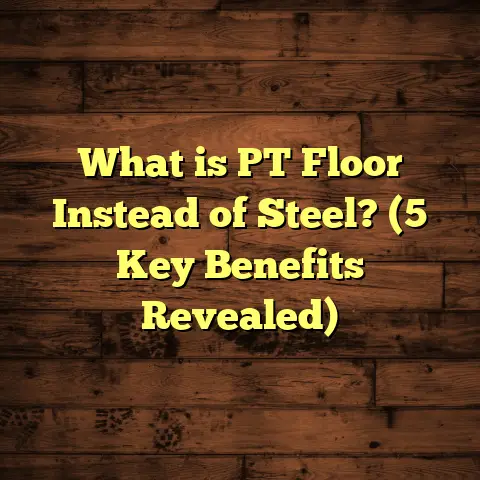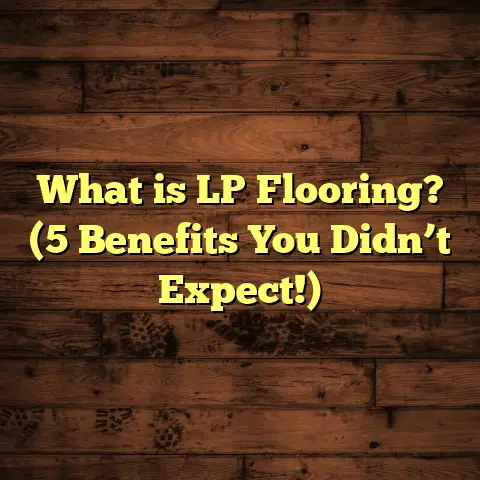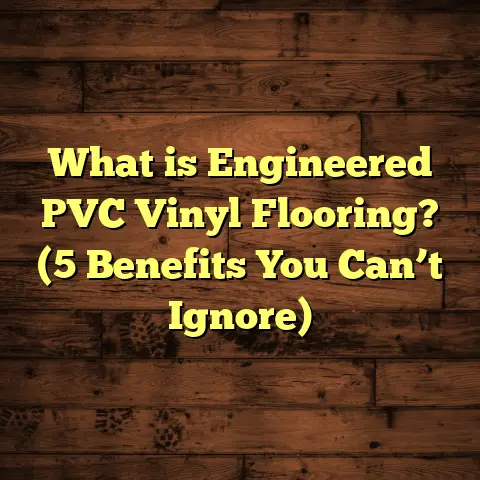What is Laminate Flooring vs Hardwood Cost? (5 Factors You Must Know)
Why You Need to Know the Cost Differences Between Laminate and Hardwood Flooring Now
If you’re thinking about upgrading your floors, you might be feeling the pressure to make the right choice quickly. Flooring isn’t just one of the biggest expenses in a renovation — it’s also something that sticks around for decades. The last thing you want is to look back and realize you spent way too much or picked a material that didn’t fit your lifestyle or budget.
I’ve been in the flooring business for years, and I’ve helped tons of homeowners make sense of the laminate vs hardwood cost dilemma. When I first started, I thought it was a simple choice: hardwood is expensive and fancy, laminate is cheap and ugly. But that’s far from true. There’s a lot more complexity here — different types of hardwood, varying qualities of laminate, plus installation nuances and maintenance costs that can totally change the picture.
Let me share everything I’ve learned so you can avoid the same confusion I had. I’ll take you through five key factors that determine how laminate and hardwood compare cost-wise — with real examples, data, and tips you can apply right away.
What Exactly Are We Comparing: Laminate Flooring vs. Hardwood Flooring Costs?
To be clear, when I say “laminate flooring,” I’m talking about flooring made by pressing multiple layers of materials together — typically fiberboard topped with a photographic layer that mimics wood grain — sealed with a protective coating. This makes laminate affordable and reasonably durable, but it’s not solid wood.
“Hardwood flooring,” on the other hand, means either solid wood planks or engineered hardwood (a top layer of real wood over plywood). Hardwood is prized for its authenticity and longevity but comes at a premium price.
So when we talk dollars and cents, we’re really comparing synthetic versus natural materials — plus everything that comes with them like installation, upkeep, and lifespan.
1. Material Price: What’s Your Budget Really Buying?
When I first started pricing flooring for clients, material was the biggest sticker shock. Laminate can be dirt cheap or surprisingly upscale depending on brand and thickness. Hardwood ranges widely too — oak costs less than exotic woods like Brazilian cherry or walnut.
Here’s a breakdown:
- Laminate: $1 to $5 per square foot.
- Hardwood: $5 to $15+ per square foot.
That’s a big range! For context, a 500 sq.ft room would cost:
- Laminate: $500 – $2,500 materials only.
- Hardwood: $2,500 – $7,500+ materials only.
What drives these differences? For laminate:
- Thickness matters: 7mm is entry-level; 12mm is premium.
- Wear layer quality affects durability.
- Brand reputation can bump prices.
For hardwood:
- Species: Common species like oak or maple cost less; rare/exotic woods cost more.
- Grade: Clear grade (fewer knots) looks nicer but costs more.
- Solid vs engineered hardwood — solid generally pricier but better for refinishing.
My story: When I first installed laminate in my rental property years ago, I chose a mid-range 10mm laminate that looked surprisingly close to real wood. It cost about $2 per sq.ft. Material-wise it saved me thousands compared to hardwood alternatives. That said, some clients later wanted upgrades to higher-end laminates with better wear layers that cost closer to $4-$5/sq.ft.
Case study: One homeowner spent $8,000 on hardwood materials for a 1,000 sq.ft living area using white oak planks. A similar laminate option would have cost around $3,500 for the same size.
So material price alone can drastically change your budget expectations.
2. Installation Costs: DIY or Hire a Pro?
Labor can be surprisingly expensive with flooring — sometimes as much as materials themselves or more.
Why Laminate Installation Is Usually Cheaper
Laminate uses a floating floor system where planks snap together without nails or glue. This means:
- Faster installation.
- No need for sanding or finishing.
- Easier DIY projects with basic tools.
Typical labor rates run $1 to $3 per sq.ft for laminate installation if you hire pros.
My experience: I installed laminate in my own home’s family room (about 400 sq.ft). Since it was floating floors with click-lock planks, I finished the job in two days with just a few basic tools. This saved me roughly $800 in labor compared to hiring someone.
Hardwood Installation Requires More Skill and Time
Hardwood floors are usually nailed or glued down and then require sanding and finishing onsite (unless prefinished planks are used). This adds complexity:
- More prep work (moisture barriers, leveling).
- Nail-down or glue-down methods require expertise.
- Sanding and finishing add time and cost.
- Dust containment during sanding can require additional mitigation steps.
Labor costs for hardwood range from $4 to $8 per sq.ft depending on region and project complexity.
Example: For a 1,000 sq.ft hardwood floor installation in a client’s home, labor alone was $6,000. The sanding/finishing took several days to complete.
Should You DIY?
If you’re handy and want to cut costs drastically, laminate is generally the better choice for DIY. Hardwood installation usually needs professional help unless you’re an experienced carpenter.
3. Maintenance Over Time: What Will You Spend in the Long Run?
Many people forget about maintenance when budgeting flooring projects — but it matters a lot.
Laminate Maintenance
Laminate is low maintenance by design:
- Regular sweeping or vacuuming.
- Occasional damp mopping with laminate-safe cleaner.
- Avoid standing water which can cause swelling.
You won’t need to refinish laminate because it has a wear layer that protects the surface. But once it wears out or gets damaged (like deep scratches or water damage), replacement is often necessary.
Annual maintenance costs are minimal — probably under $50/year for cleaning supplies.
Real-life: I had a client whose laminate floor lasted about 15 years with normal wear before some planks needed replacing due to pet damage.
Hardwood Maintenance
Hardwood requires more attention:
- Sweeping/vacuuming regularly.
- Using hardwood-safe cleaners.
- Refinishing every 7–10 years to restore surface.
- Occasional spot repairs for scratches/dents.
- Protecting from moisture exposure carefully.
Refinishing can cost between $2-$4 per sq.ft depending on area size.
Over 15 years, expect maintenance costs around $150/year or more when factoring in refinishing cycles.
My advice: If you want floors that improve with age and can be refreshed repeatedly, hardwood is worth it. But if you want hassle-free cleaning without refinishing headaches, laminate is easier.
4. Durability and Lifespan: How Long Will Your Floors Last?
One of the biggest questions I get: “How long will my floors last?”
Laminate Lifespan
Quality laminate typically lasts 10–20 years depending on:
- Traffic level.
- Exposure to moisture.
- Quality of wear layer.
It’s durable against scratches but vulnerable if water seeps underneath or if pieces chip/crack. Also, it can’t be sanded or refinished like wood because it’s a composite material.
Hardwood Lifespan
Hardwood floors can last 50+ years if cared for properly because:
- They can be sanded/refinished multiple times.
- Solid wood is naturally tougher than laminate composites.
- Aging often adds character that many homeowners love.
I’ve seen century-old hardwood floors restored beautifully in historic homes — something no laminate floor can match.
What Does This Mean for Cost?
Even though hardwood costs more upfront and requires periodic refinishing, its longevity spreads those costs over decades. Laminate may need replacement sooner which means recurring expenses if you want to keep your floors looking good long-term.
5. Appearance and Home Value: How Does Cost Tie Into Style?
Let’s be honest — floors set the tone for your entire space. You want them to look good now and still appeal years down the road.
How Hardwood Adds Value
Real wood flooring has proven resale value benefits:
- Studies show homes with hardwood floors sell faster.
- Hardwood flooring can increase resale value by 1–2% compared to carpet or laminate alternatives.
- Buyers often perceive hardwood as higher quality and more desirable.
In one project I handled recently, the homeowners upgraded from carpet to white oak hardwood before listing their house. It sold within two weeks at above asking price — they credited much of this to the new floors.
Laminate Looks Today Are Better Than Ever
Modern laminates use HD printing technology that creates realistic wood grain patterns and textures. Some even have embossed surfaces matching wood texture closely.
You can find laminates that mimic exotic woods at a fraction of the price. This opens design possibilities if you want a trendy look without splurging on natural wood species.
Personal note: For my rental property’s living room remodel, I chose gray-tone laminate planks that looked very modern and fresh without breaking my bank. It still gets compliments!
Breaking Down Real Projects: My Own Flooring Decisions
I want to share my personal experience remodeling my family room (~400 sq.ft) so you get a realistic sense of how this plays out financially:
| Item | Laminate Flooring | Hardwood Flooring |
|---|---|---|
| Material Cost | $1.80/sq.ft → $720 | $8/sq.ft → $3,200 |
| Installation Cost | $2/sq.ft → $800 | $6/sq.ft → $2,400 |
| Maintenance (annual) | ~$50 | ~$150 |
| Lifespan | ~15 years | 50+ years |
Upfront total:
- Laminate: ~$1,520
- Hardwood: ~$5,600
Over 15 years including maintenance:
- Laminate: ~$2,270
- Hardwood: ~$7,850 (with one refinishing cycle)
At first glance, laminate saved me nearly $4k upfront and still provided great looks and function for everyday family life. However, if I planned to stay decades or resell soon at a premium price point, hardwood might have been worth the investment despite the higher initial costs.
What About Engineered Hardwood? Where Does That Fit In?
Engineered hardwood deserves a quick mention because it blends some features of both:
- It has a thin layer of real wood over plywood layers.
- Costs less than solid hardwood ($4-$10/sq.ft).
- Easier installation than solid wood (can click-lock).
- Can be refinished once or twice but not as many times as solid wood.
- More moisture-resistant than solid hardwood (good for basements/kitchens).
I’ve used engineered hardwood in many projects where clients wanted real wood look at moderate price without solid wood drawbacks like expansion issues in humid climates.
Installation cost is often similar to laminate but slightly higher due to finishing needs sometimes.
Additional Costs You Might Not Expect
When budgeting flooring projects, here are some hidden expenses I’ve learned from experience:
Subfloor Preparation
Old floors might need leveling or repair before new materials go down. Cost varies widely but expect $1-$3/sq.ft extra if needed.
Trim and Molding
New baseboards or quarter round molding often replace old trim — budget a few hundred dollars depending on room size and style choices.
Removal of Old Floors
Tearing out carpet or old hardwood adds labor costs — usually $1-$2 per sq.ft extra but depends on floor type and disposal fees.
Waste Factor
Always order slightly more material than square footage needed (usually 5%-10%) to accommodate cuts and mistakes. Flooring calculators like FloorTally help estimate this precisely based on your room shape.
Tips From My Experience for Saving Money Without Sacrificing Quality
- Shop Around Materials: Don’t settle for first quote; brands vary greatly in price/quality for both laminate and hardwood.
- Consider Prefinished Hardwood: Saves on sanding/finishing labor costs compared to site-finished floors.
- DIY Laminate Installation: If you’re comfortable with basic tools, this can save hundreds or thousands.
- Ask About Bulk Discounts: For larger projects or multiple rooms — suppliers often offer deals.
- Plan for Future Upgrades: If budget is tight now but you want hardwood eventually, start with good-quality laminate that can be replaced later.
- Maintain Floors Properly: Extends lifespan whether laminate or hardwood—keep floors clean and avoid water damage.
- Use Online Tools Like FloorTally: For accurate budgeting including waste factor and labor estimates specific to your location and materials chosen.
Common Questions I Get About Laminate vs Hardwood Cost
Q: Will laminate ever look exactly like real wood?
A: Not quite yet—but high-end laminates are getting close visually. You won’t get the authentic grain depth or feel underfoot that real wood provides though.
Q: Is hardwood always more eco-friendly?
A: Not necessarily—sustainably sourced engineered hardwood has lower environmental impact than some laminates made from plastics. But both have options certified by environmental groups now.
Q: Can I install hardwood over concrete?
A: Engineered hardwood can be glued down over concrete; solid hardwood usually requires plywood subfloor over concrete — adding cost.
Q: Which is better for pets?
A: Laminate is scratch-resistant but susceptible to water damage from accidents; some hardwoods are harder but show scratches more easily. Protective finishes help either way.
Wrapping Up My Thoughts After Years Working With Both Options
Laminate flooring offers excellent value upfront with easy installation and low maintenance—great if your budget is tight or you want quick results without hassle.
Hardwood floors are an investment in beauty and longevity that pay off over decades through refinishing options and increased home value—but they come with higher upfront costs and upkeep needs.
I encourage you to think about your lifestyle, how long you plan to stay in your home, your willingness to maintain floors, and your design goals before deciding between these two popular options.
If you want help running exact numbers tailored to your home size and local labor/material prices before making the call, tools like FloorTally give fantastic detailed estimates—saving time and preventing surprises during your project budgeting phase.
Feel free to ask me any specific questions about your own project—I’m happy to share more insights from my hands-on experience!





